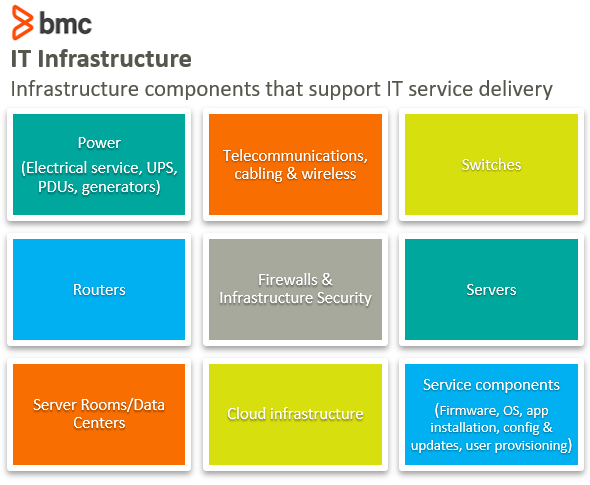In this article, we’ll look at the important role of Infrastructure Manager, including:
What does an Infrastructure Manager do?
The Infrastructure Manager is responsible for the design, installation, maintenance, and retirement of the systems and personnel that are at the core of an organization. The services under the responsibility of the Infrastructure Manager are typically the underpinning (or supporting) services, or infrastructure, that enable the delivery of customer-facing IT services.

Peers and Reporting
An Infrastructure Manager is usually part of the senior management team in an IT organization.
- In larger organizations, the Infrastructure Manager may report to an Operations Director that oversees additional areas.
- In smaller organizations, the Infrastructure Manager will report to the CIO or senior leader in the IT organization.
To deliver IT services, the Infrastructure Manager works alongside:
- The service desk
- Security teams
- Development teams
- Project managers
Areas of responsibility
Generally, an Infrastructure Manager is responsible for several areas:
- Staff management
- Vendor management
- Standards and procedures
- Strategy
- Monitoring and reporting
- Infrastructure software
Let’s look at each.
Staff management
The Infrastructure Manager typically oversees staff in three functional areas:
1. Networking
The Infrastructure Manager will manage the staff and equipment that handles switching, routing, and in some cases perimeter devices (firewalls).
Most larger organizations have transitioned the firewalls to being the responsibility of the security team. In those cases, it is important that the Infrastructure Manager build a strong relationship with the security team to ensure smooth infrastructure service operations.
In organizations without a dedicated security team, the Infrastructure Manager should have at least one person who has the responsibility for ensuring the IT security of the organization. In very small organizations this can be the responsibility of the Infrastructure Manager.
2. Servers
The Infrastructure Manager must have a good understanding of server technologies and the server team. This normally includes:
- Operating systems
- Physical and virtual servers
- Storage and backups
- Disaster recovery
3. Physical Cabling
Only the largest organizations have internal teams responsible for physically pulling network cabling. However, the Infrastructure Manager must be well versed on all types of physical and fiber optic cabling. I’ve seen situations where failure to consider data transfer speeds and associated cabling requirements have been instrumental (and devastating) to server room and data center projects.
Vendor management
In most IT organizations, the staff works with external vendors to support hardware and software. The Infrastructure Manager is responsible for establishing strong partnerships with those vendors to set clear expectations. This includes:
- Negotiating access agreements
- Establishing service level agreements (SLAs)
- Ensuring contracts are in place to support the services provided by the infrastructure team
Standards & procedures
Perhaps the most important role of the Infrastructure Manager is to ensure that standards and procedures are in place for the work of his or her team. This includes establishing, writing, and distributing governance and enforcing the governance that’s already in place.
Technology infrastructure is inherently complex. This complexity is best mitigated by establishing standard ways of work that ensures the technical teams work together in a consistent manner. Although it may seem the opposite, standard procedures actually enable the organization to be more agile and more adaptable to change. Think about it: which sounds like more work—writing a script to change the configuration on 200 servers, or manually changing the configuration on 200 servers because each one was set up in a unique way?
Strategy
The Infrastructure Manager must be more than just an expert at managing technology. The Infrastructure Manager must be aware of the strategic direction of the organization as well as new technologies on the horizon. The Infrastructure Manager must be able to use this knowledge to select the right technology that enables the organization to move forward, rather than waiting on the IT department.
Furthermore, the highly successful Infrastructure Manager must be able to lay out a strategy that the CIO and other executives will understand and support. This means going beyond understanding what the technology does at a systems engineer level. The Infrastructure Manager must understand how that technology relates to the goals of the department and larger organization.
Monitoring & reporting
I once read a comic where it showed an IT guy in front of the computer with the caption “Network hasn’t gone down in 2 years, everyone wonders what the IT guys does.” Then, next to it, another caption that said “Network has been down for 2 minutes, everyone wonders what the IT guy does.”
Without proper metrics and monitoring, this can quickly become the opinion that senior leadership has of the Infrastructure Manager. The Infrastructure Manager needs to:
- Put a strong monitoring system in place
- Produce standard reports on the status of the infrastructure
- Regularly communicate what they are doing and how their work relates to the success of the organization
By doing this, the Infrastructure Manager can bring visibility into work that happens ‘behind the scenes’ when compared with the rest of the organization.
Infrastructure software
One responsibility that is frequently overlooked? Ensuring the right software and tools are in place to manage the infrastructure. This goes beyond the OS selection. What I’m talking about here are things like software monitoring, device, OS patching, and configuration management tools.
The modern Infrastructure Manager
Many organizations are already focused on cloud first solutions. There are significant advantages to a cloud first approach for new organizations. But well established organizations have a lot to consider when investigating cloud solutions: cloud first or cloud smart? Cost should not be the only consideration for Infrastructure Managers. Cloud based solutions can bring greater agility to the overall infrastructure and allow it to respond to business demands more rapidly.
The modern Infrastructure Manager must consider cloud-based solutions as part of the infrastructure toolkit and know how to leverage its benefits to deliver a competitive advantage for the organization. Key to this understanding is having the proper tools and people in place to effectively manage the infrastructure services regardless of whether they are on premise or in the cloud.
Additional resources
For more on this topic, explore these resources:
- BMC IT Operations Blog
- BMC Business of IT Blog
- IT Infrastructure Planning: How To Get Started
- Infrastructure Monitoring vs Management: What’s The Difference
These postings are my own and do not necessarily represent BMC's position, strategies, or opinion.
See an error or have a suggestion? Please let us know by emailing blogs@bmc.com.






